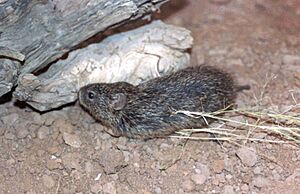Tawny-bellied cotton rat facts for kids
Quick facts for kids Tawny-bellied cotton rat |
|
|---|---|
 |
|
| S. fulviventer in Janos, Chihuahua, Mexico | |
| Conservation status | |
| Scientific classification | |
| Genus: |
Sigmodon
|
| Species: |
fulviventer
|
The tawny-bellied cotton rat (Sigmodon fulviventer) is a type of rodent that belongs to the family Cricetidae. You can find it in Mexico and in the U.S. states of Arizona and New Mexico.
Contents
What Does It Look Like?
Male and female tawny-bellied cotton rats look very similar. Adult males are usually a little heavier than females. A male might weigh about 222 grams, while a female weighs around 206 grams.
Their tail has small scales and is covered in hair. This is different from the hispid cotton rat (Sigmodon hispidus), which has larger scales on its tail. Another way to tell them apart is by their skull. The tawny-bellied cotton rat has a short, wide skull, not a long one. Their teeth are strong, with well-developed front teeth and high back teeth.
Fur and Whiskers
The fur on their belly is a yellowish-brown color, which is why they are called "tawny-bellied." Their back fur is a mix of black and tan, giving it a speckled look. They have three kinds of hair on their body:
- Guard hair (the longest)
- Guard-awl hair
- Under hair (the shortest)
They also have Whiskers on their face. These whiskers help them keep their balance, especially when they are swimming!
Where Do They Live?
These cotton rats live in the grasslands of central Mexico. Their home range stretches north into central and southwestern New Mexico and southeastern Arizona. They really like places with lots of thick grass. In these grassy areas, they build special paths called "runways." These runways look like tunnels covered by grass, helping them move around safely.
What Do They Eat?
Tawny-bellied cotton rats mostly eat grasses, especially a type called bunchgrass. They also use this grass to build their nests.
Climate Change and Their Home
In central New Mexico, the area where these rats live is getting bigger. This is happening because of changes in the climate, like more rain and warmer temperatures.
Neighbors: Hispid Cotton Rats
The tawny-bellied cotton rat often lives in the same areas as its close relative, the hispid cotton rat. However, the tawny-bellied cotton rat prefers wetter places, while the hispid cotton rat likes drier areas. Even when they live next to each other, they tend to avoid each other. One species might become more common, while the other stays in smaller numbers. In some places, like Durango, Mexico, the tawny-bellied cotton rat is more common. This might be because it's better at living in specific conditions, while the hispid cotton rat can live in many different types of places.
Why Are They Important for Science?
The tawny-bellied cotton rat is very important in science. Scientists use them to study and test new ways to treat sicknesses that affect humans. This is because these rats can get many of the same sicknesses caused by tiny viruses and bacteria that humans can get. Studying them helps scientists create new vaccines and medicines.
Good Test Subjects
Scientists like using these rats for studies because:
- They have special groups that are very similar to each other (inbred strains).
- They are easy to handle.
- They are not expensive to take care of.
Some of the sicknesses studied using cotton rats include certain breathing problems and lung infections.
Helping with Human Sicknesses
In 1998, a study found that tawny-bellied cotton rats can get a low level of a certain human virus. When they get sick, their body reacts in a similar way to how a human body would. This makes them very helpful for understanding how to fight these sicknesses. Scientists can even make changes to the rats' cells to make them even better for testing.
These rats have also been found to get a lung infection in a similar way to humans. Before, scientists used other small rodents or rabbits. Cotton rats are a great choice because they combine the best parts of both: they get lung problems like rabbits do, and they are easy and cheap to care for like other small rodents. Future research is looking into using cotton rats to study lung infections that are made worse by other sicknesses, because of how similar they are to humans in both situations.


